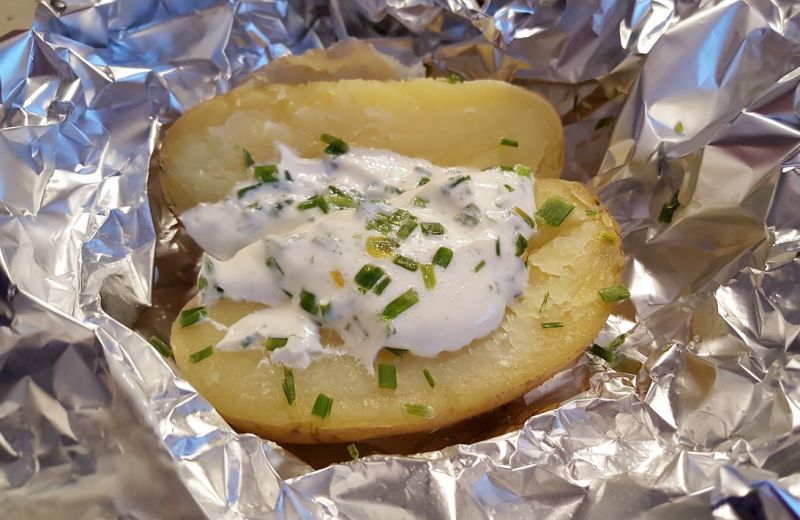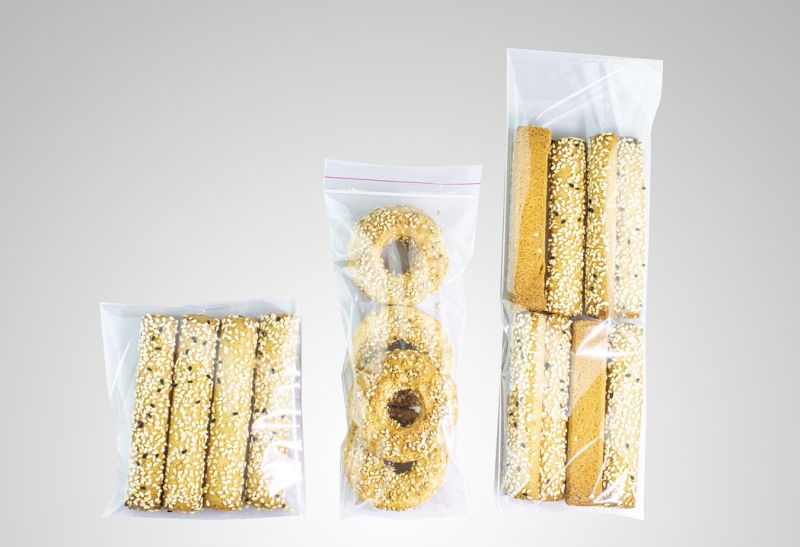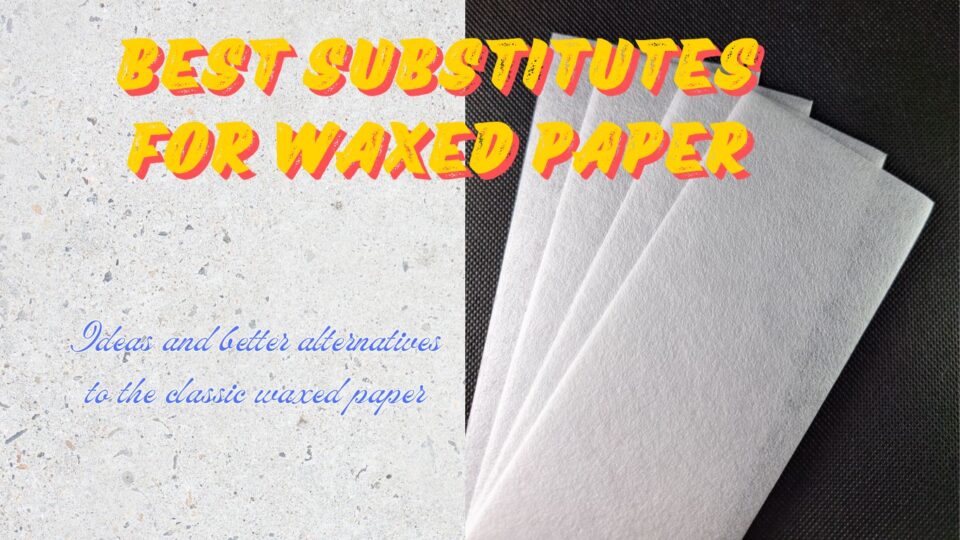Did you run into an old recipe or home tips that suggest the use of waxed paper but you’d rather not be bothered to buy it? That makes sense. And let’s be clear, there are plenty of things that can substitute for waxed paper.
Some decades ago, waxed paper was all the rage for packing foods and similar miscellaneous applications. It is/was not to be used for cooking, baking, or any applications that involve heat.
Though its peak of popularity passed more than half a century ago, it still has some uses and continues to be used in some applications. Yet, there are better options now, and indeed, many of the wax paper substitutes are superior options.
The top substitutes for waxed paper are parchment paper, aluminum foil, teflon sheets, freezer paper, ziploc food bags, and good old-fashioned greasing.
Let’s learn more about waxed paper, its substitution options and what they offer.
Table of Contents
A Quick Note On The Characteristics And Uses Of Waxed Paper
As its name implies, waxed paper is paper coated with wax on both sides. The thin layer of wax is usually paraffin wax, though it can also be other wax types like soy wax and beeswax. One reason for its popularity was that wax doesn’t feel greasy at room temperature.
Besides, the thin coat of wax is enough to keep it waterproof. As a result, the food stored inside the waxed paper wouldn’t leak. Secondly, if you’re storing food, like packing a sandwich for lunch, waxed paper would keep it fairly well packed, without altering the taste or letting the food dry out.
Apart from packing, it also found (and continues to be popular for) culinary applications, especially baking preparation. Since the wax makes the paper non-stick and the wax used for cooking applications is non-toxic, it found many takers in baking.
You can put unbaked cookies or similar other materials on it before transferring them to the oven. Since the waxed paper is easy to use and relatively cheap, it works splendidly well for such applications.
Of course, the paper and the wax are not heat resistant and shouldn’t go into the oven. Wax used for the paper has a really low melting point and can easily get into food. Then there’s always the danger of the wax or paper catching fire. Even if that could be avoided, food mixed with wax doesn’t taste good. So, yeah, don’t cook or bake with waxed paper!
Another application of waxed paper is using it as a layering when stacking baked goods like cookies in a container. It keeps the layering neat and also helps the cookies maintain their shape.
There are several other uses of waxed paper. This isn’t intended as an exhaustive description, but as a quick understanding of the uses of waxed paper.
The Scope Of Substitutions Discussed
Our scope of the substitutions discussed limits itself to the uses of waxed paper. Many of these discussions often branch into substitutions for parchment paper as well, considering the similarities between the two.
However, parchment paper and waxed paper are different products. And since parchment paper can actually be used for cooking and baking, the dynamic of the substitution can change entirely.
So, we will focus only on waxed paper and related relevant substitutions. Options like silpat (silicone mats) and silicone molds will not be discussed since they’re more relevant as parchment paper substitutes in baking, rather than waxed paper substitutes. However, teflon sheets are discussed, considering their versatility and obvious replacement for waxed paper.
Top Waxed Paper Substitutes And Their Uses
1. Parchment Paper
In modern use, parchment paper and wax paper are terms that are often used interchangeably. And that’s for good reason, since both of these have very similar construction and uses.
However, they’re not the same and there are notable differences. For one, waxed paper is considerably cheaper than parchment paper. But, parchment paper can be significantly more versatile and allows reuse in some applications.
The key element here is that parchment paper gets a thin coating of food-safe silicone, rather than the wax used for waxed paper. Using silicone increases the cost, but makes parchment paper a superior option.
It can do everything waxed paper does – and parchment paper can do it better. It is good for non-stick food applications, packaging, and similar uses. Thanks to the silicone coat, it can even go into the oven and is safe for temperatures up to 425°F.
2. Aluminum Foil

Aluminum foil has been a very popular way of storing and packaging food for a long time now. It is non-stick, doesn’t alter the flavor of the packaged food, and is waterproof. It can also be used for cooking or baking, though it’s better to apply a layer of oil or grease on the foil so that it doesn’t stick to the food.
However, in recent years, there have been increased fears of aluminum foil leaching aluminum into food, especially when used for cooking and baking.
While that is not considered a major problem or health issue at the moment, the mere possibility is enough to make several people give up on the use of aluminum foil.
Most of these fears of aluminum leaching are based on studies where the foil was used for cooking. If you intend to use it simply for packaging, the use of foil shouldn’t be a problem.
It is possible to reuse aluminum foil, especially if it has been used simply for packaging. However, the foil is thin and crumples easily, so you’ll have to be careful while managing and washing it for reuse.
3. Teflon Sheets

Teflon sheets or PTFE sheets are an interesting and significantly more expensive alternative to waxed paper. In fact, they can do pretty much everything waxed paper can do, and do it better.
In some ways, they’re even better than parchment paper, since they have a higher temperature resistance when used for cooking or baking. Teflon sheets can handle temperatures up to 500°F (260°C) and can be used for a variety of cooking purposes, including their use as oven liners. They can even be cut to preferred size and used without a problem.
However, the general trend has people moving away from non-stick PTFE products for food use, so teflon sheets are generally sold as heat press liners for printing and similar crafts.
Yet, if you intend to use them as replacements for waxed papers, teflon sheets should be a great option. Using them merely as a non-stick surface that isn’t used for cooking, baking, or otherwise exposed to high temperatures should remove worries about PTFE/teflon use.
Teflon sheets are reusable and can be used for a long time. Cleaning them is as easy as wiping them with a soft cloth, so there is a relative ease and convenience to their use. Despite their initially high price, their reusability can make teflon sheets an easier and even more cost effective option as compared to waxed paper.
4. Freezer Paper (Butcher Paper)
Freezer paper is usually a paper with plastic lining on one side. It’s sometimes also known as butcher paper because many butchers use it for packing and storing meat.
The presence of plastic coating on the paper makes it waterproof, thus allowing its use as food storage. You could also use this paper to wrap the food and place it in a refrigerator or freezer.
Similarly, a sheet of this paper laid in the kitchen can work in a similar way as waxed paper. While the plastic isn’t exactly non-stick, it’s tolerably useful and can work for baking preparation without a problem. If in doubt, it’s always possible to add a layer of oil over the plastic manually or through a cooking spray to get a better non-stick surface.
Though it’s needless to add, do remember that the coating is plastic and should not be used for cooking, baking, or any other purpose that involves heat.
5. Plastic Wrap
Decades ago, plastic wrap was what unseated waxed paper from its popularity as the preferred method for packing food. The cling plastic wraps, like the better-known Saran Wrap were cheaper, easier to use, offered better waterproofing and were more reliable than waxed paper.
As such, much of food storage and food carrying duties were handled by plastic wrap. It still continues to be decently popular for storing food or carrying lunch.
However, plastic, especially single use plastic like Saran Wrap or cling plastic wraps are losing popularity due to the possible health issues of plastic contamination of food. Environmental concerns are a major issue as well, so it’s safe to say that plastic wrap has fallen out of style.
6. Ziploc Bags Or Similar

While Ziploc is a brand name, it has become synonymous with several types of plastic bags used for food storage or similar purposes. Usually made from high-grade plastic, the bags are fairly popular for carrying and packing food, and even for storing food at home in a refrigerator or freezer.
The bags offer reasonable protection for packaged food, protecting it from moisture and air. They can also be reused several times, though cleaning them can feel like a hassle.
Of course, these bags can’t be used for baking prep (like by placing unbaked cookies over them), since they’re not non-stick in the truest sense of the way.
7. Using A Conventional Paper Bag
Using a conventional plain paper bag can be useful if all you have to do is to package some dry (or not-so-wet) foods for a short time. As an example, they can be quite okay to carry something like sandwiches for a short duration.
However, if you do intend to use it for food, make sure it’s a good quality and odorless paper bag. Most paper bags tend to have a paper smell about them which will easily get into food, making it far less appetizing.
One way around this is to wrap the food in soft, dry tissues first, so the food interacts less with the bag.
This is not the most elegant or useful idea, but it’s something to consider if you need a quick fix.
8. Doing It The Old-Fashioned Way With Grease
This alternative speaks more to the baking prep or food-prep side of the uses of waxed paper. If you can’t use waxed paper in such a scenario, it might be worthwhile to consider handling things the old fashioned way, with grease and some flour.
The classic way of doing this is to grease the baking pan (or prep pan) with oil, butter, or similar greasing of your choice. Sprinkling a bit of flour on it makes it a very useful non-stick surface for baking or baking-prep. Apart from baking prep, this method is fairly popular and useful if you intend to use it for baking too.
If you’d rather not grease a pan manually, a similar effect can be achieved through the use of cooking spray or baking spray.
Choosing The Right Substitute For Waxed Paper
When choosing the right substitute for waxed paper, your key concern should be application. Waxed paper is used for packaging, baking prep, and other miscellaneous uses. If you’re looking at packaging, consider similar solutions like aluminum foil, freezer paper, plastic wrap, ziploc bags, or just plain paper bags.
However, there are substitutes like teflon paper or parchment paper that can do everything waxed paper can do, all the way from packaging to baking preparation. In fact, both of these can even be used during baking, thus making the process easier. Though remember that waxed paper shouldn’t be used for cooking or any application that involves heat.

